Business Strategy Report: ALDI's Strategic Planning, Audit & Growth
VerifiedAdded on 2020/09/17
|23
|6678
|41
Report
AI Summary
This report provides a comprehensive analysis of ALDI's business strategy, encompassing various aspects of strategic planning. It begins with an introduction to business strategy, defining its role in achieving organizational goals and objectives, and highlighting the importance of aligning strategies with a firm's strengths, resources, and opportunities. The report then delves into ALDI's goals, mission, vision, objectives, and core competencies. The report includes an organizational and environmental audit of ALDI using SWOT analysis and Porter's Five Forces model. Furthermore, it explores the significance of stakeholder analysis in formulating new strategies and presents a new strategy for ALDI's growth. The report also discusses product development and market growth strategies, and examines the roles and responsibilities of personnel, resource requirements, and the application of SMART targets in achieving strategic objectives. Strategic planning tools and techniques, such as the BCG matrix and SPACE matrix, are discussed to evaluate ALDI’s business portfolio and strategy. The conclusion summarizes the key findings and recommendations for ALDI's strategic development.
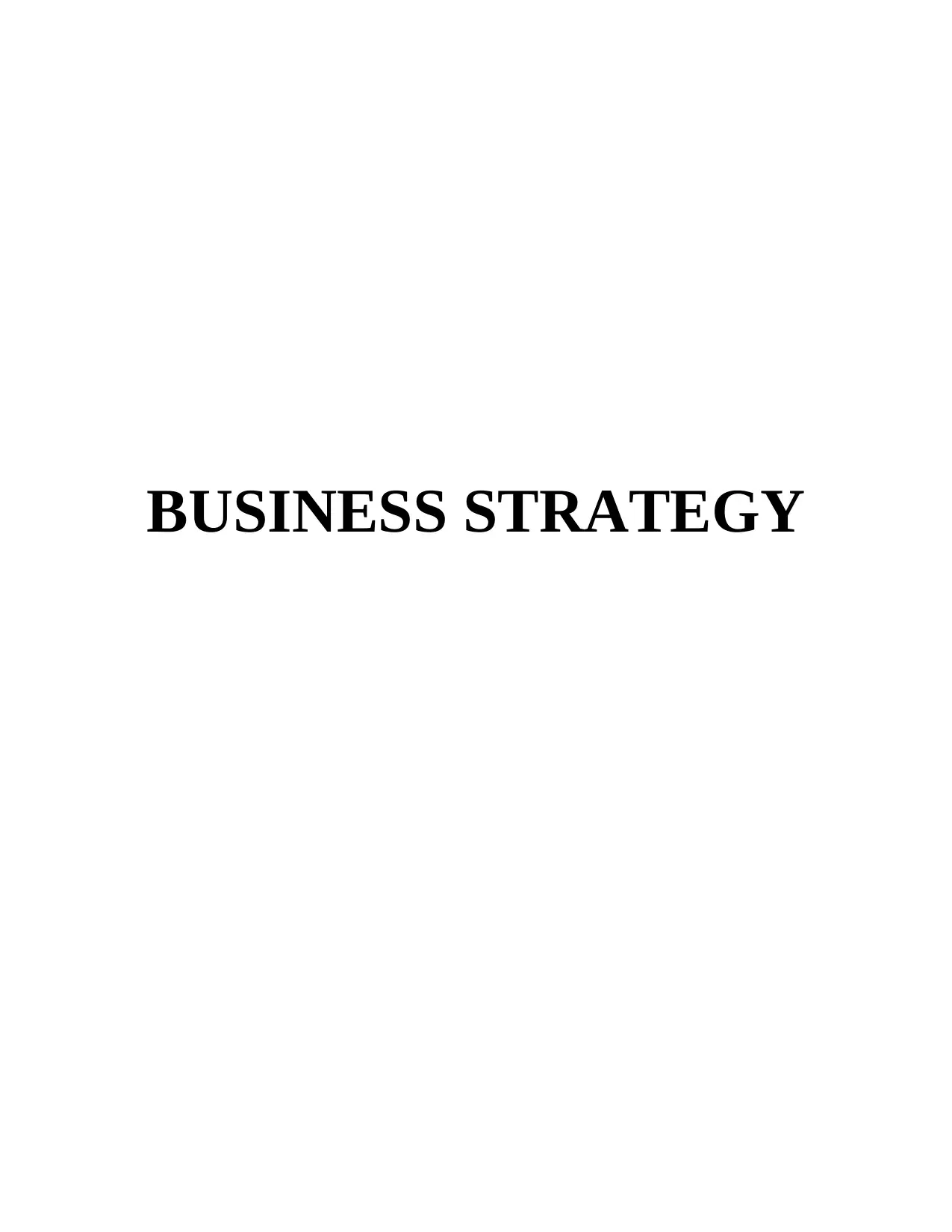
BUSINESS STRATEGY
Paraphrase This Document
Need a fresh take? Get an instant paraphrase of this document with our AI Paraphraser
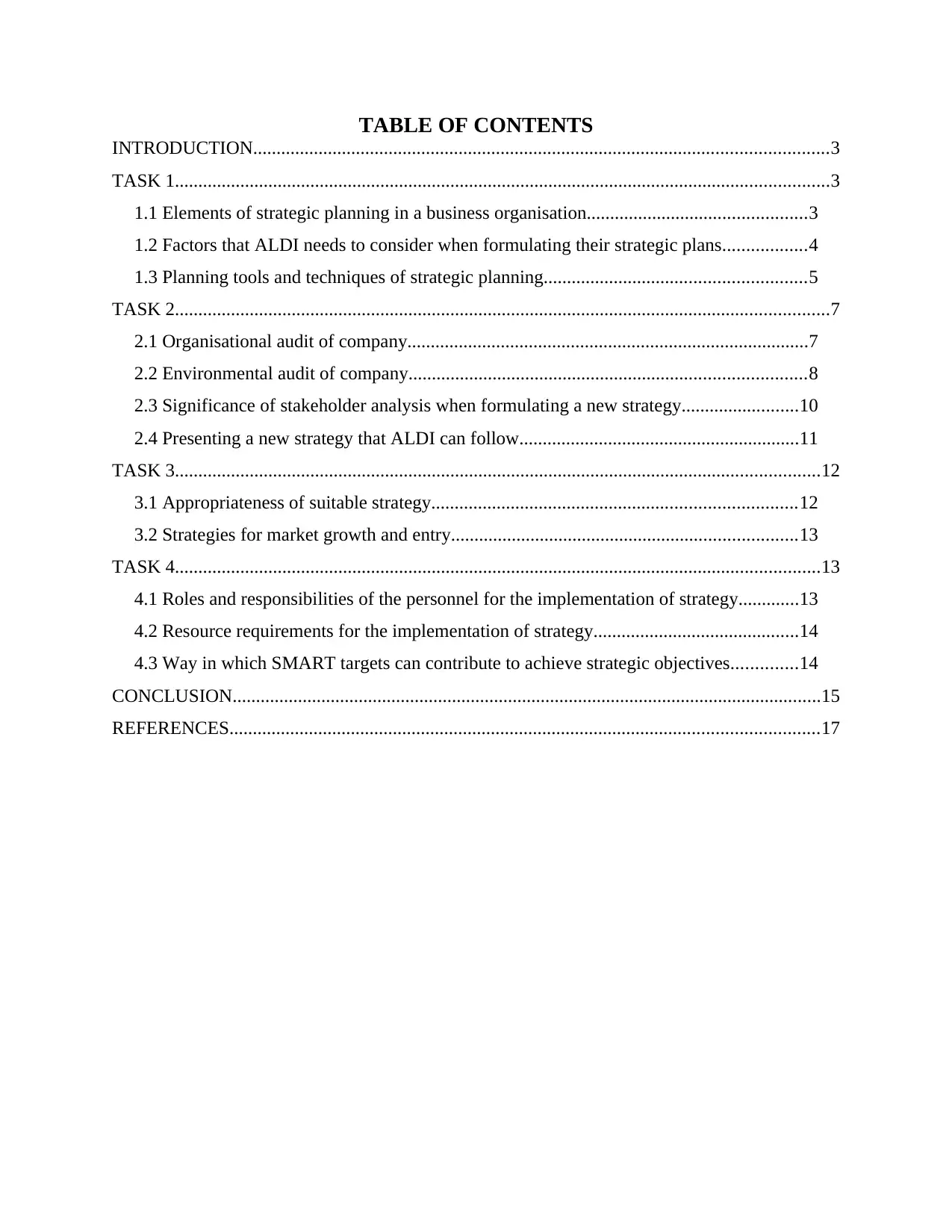
TABLE OF CONTENTS
INTRODUCTION...........................................................................................................................3
TASK 1............................................................................................................................................3
1.1 Elements of strategic planning in a business organisation...............................................3
1.2 Factors that ALDI needs to consider when formulating their strategic plans..................4
1.3 Planning tools and techniques of strategic planning........................................................5
TASK 2............................................................................................................................................7
2.1 Organisational audit of company......................................................................................7
2.2 Environmental audit of company.....................................................................................8
2.3 Significance of stakeholder analysis when formulating a new strategy.........................10
2.4 Presenting a new strategy that ALDI can follow............................................................11
TASK 3..........................................................................................................................................12
3.1 Appropriateness of suitable strategy..............................................................................12
3.2 Strategies for market growth and entry..........................................................................13
TASK 4..........................................................................................................................................13
4.1 Roles and responsibilities of the personnel for the implementation of strategy.............13
4.2 Resource requirements for the implementation of strategy............................................14
4.3 Way in which SMART targets can contribute to achieve strategic objectives..............14
CONCLUSION..............................................................................................................................15
REFERENCES..............................................................................................................................17
INTRODUCTION...........................................................................................................................3
TASK 1............................................................................................................................................3
1.1 Elements of strategic planning in a business organisation...............................................3
1.2 Factors that ALDI needs to consider when formulating their strategic plans..................4
1.3 Planning tools and techniques of strategic planning........................................................5
TASK 2............................................................................................................................................7
2.1 Organisational audit of company......................................................................................7
2.2 Environmental audit of company.....................................................................................8
2.3 Significance of stakeholder analysis when formulating a new strategy.........................10
2.4 Presenting a new strategy that ALDI can follow............................................................11
TASK 3..........................................................................................................................................12
3.1 Appropriateness of suitable strategy..............................................................................12
3.2 Strategies for market growth and entry..........................................................................13
TASK 4..........................................................................................................................................13
4.1 Roles and responsibilities of the personnel for the implementation of strategy.............13
4.2 Resource requirements for the implementation of strategy............................................14
4.3 Way in which SMART targets can contribute to achieve strategic objectives..............14
CONCLUSION..............................................................................................................................15
REFERENCES..............................................................................................................................17
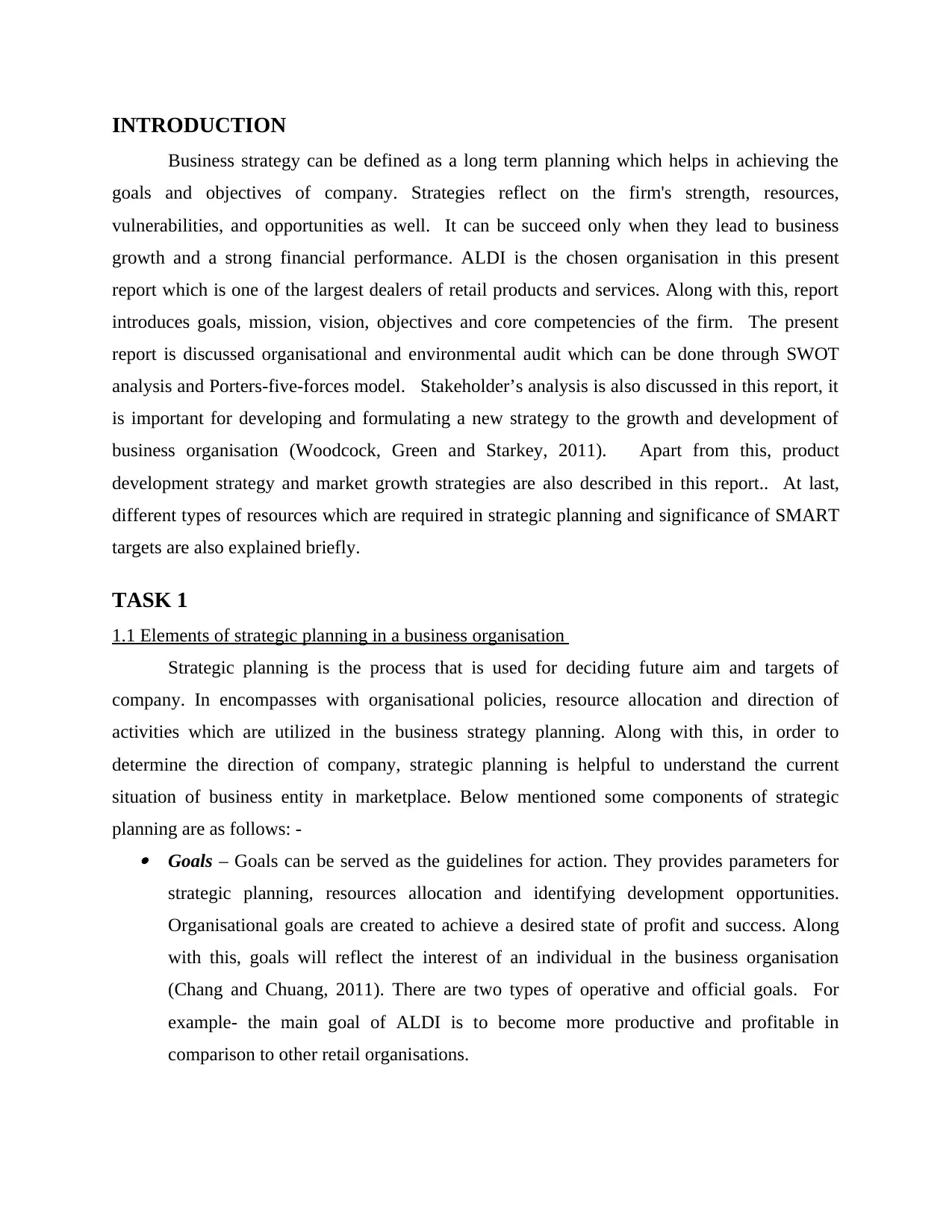
INTRODUCTION
Business strategy can be defined as a long term planning which helps in achieving the
goals and objectives of company. Strategies reflect on the firm's strength, resources,
vulnerabilities, and opportunities as well. It can be succeed only when they lead to business
growth and a strong financial performance. ALDI is the chosen organisation in this present
report which is one of the largest dealers of retail products and services. Along with this, report
introduces goals, mission, vision, objectives and core competencies of the firm. The present
report is discussed organisational and environmental audit which can be done through SWOT
analysis and Porters-five-forces model. Stakeholder’s analysis is also discussed in this report, it
is important for developing and formulating a new strategy to the growth and development of
business organisation (Woodcock, Green and Starkey, 2011). Apart from this, product
development strategy and market growth strategies are also described in this report.. At last,
different types of resources which are required in strategic planning and significance of SMART
targets are also explained briefly.
TASK 1
1.1 Elements of strategic planning in a business organisation
Strategic planning is the process that is used for deciding future aim and targets of
company. In encompasses with organisational policies, resource allocation and direction of
activities which are utilized in the business strategy planning. Along with this, in order to
determine the direction of company, strategic planning is helpful to understand the current
situation of business entity in marketplace. Below mentioned some components of strategic
planning are as follows: - Goals – Goals can be served as the guidelines for action. They provides parameters for
strategic planning, resources allocation and identifying development opportunities.
Organisational goals are created to achieve a desired state of profit and success. Along
with this, goals will reflect the interest of an individual in the business organisation
(Chang and Chuang, 2011). There are two types of operative and official goals. For
example- the main goal of ALDI is to become more productive and profitable in
comparison to other retail organisations.
Business strategy can be defined as a long term planning which helps in achieving the
goals and objectives of company. Strategies reflect on the firm's strength, resources,
vulnerabilities, and opportunities as well. It can be succeed only when they lead to business
growth and a strong financial performance. ALDI is the chosen organisation in this present
report which is one of the largest dealers of retail products and services. Along with this, report
introduces goals, mission, vision, objectives and core competencies of the firm. The present
report is discussed organisational and environmental audit which can be done through SWOT
analysis and Porters-five-forces model. Stakeholder’s analysis is also discussed in this report, it
is important for developing and formulating a new strategy to the growth and development of
business organisation (Woodcock, Green and Starkey, 2011). Apart from this, product
development strategy and market growth strategies are also described in this report.. At last,
different types of resources which are required in strategic planning and significance of SMART
targets are also explained briefly.
TASK 1
1.1 Elements of strategic planning in a business organisation
Strategic planning is the process that is used for deciding future aim and targets of
company. In encompasses with organisational policies, resource allocation and direction of
activities which are utilized in the business strategy planning. Along with this, in order to
determine the direction of company, strategic planning is helpful to understand the current
situation of business entity in marketplace. Below mentioned some components of strategic
planning are as follows: - Goals – Goals can be served as the guidelines for action. They provides parameters for
strategic planning, resources allocation and identifying development opportunities.
Organisational goals are created to achieve a desired state of profit and success. Along
with this, goals will reflect the interest of an individual in the business organisation
(Chang and Chuang, 2011). There are two types of operative and official goals. For
example- the main goal of ALDI is to become more productive and profitable in
comparison to other retail organisations.
⊘ This is a preview!⊘
Do you want full access?
Subscribe today to unlock all pages.

Trusted by 1+ million students worldwide
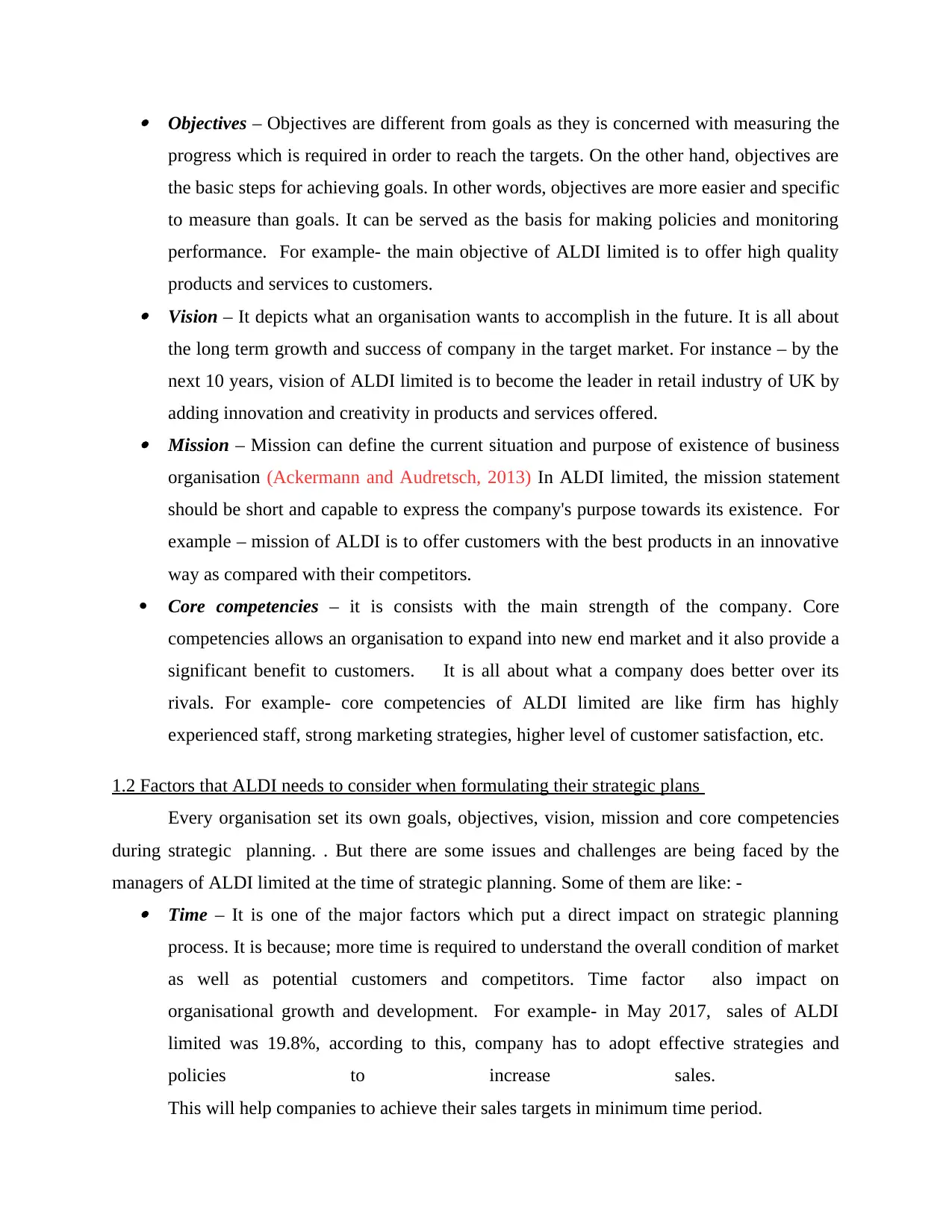
Objectives – Objectives are different from goals as they is concerned with measuring the
progress which is required in order to reach the targets. On the other hand, objectives are
the basic steps for achieving goals. In other words, objectives are more easier and specific
to measure than goals. It can be served as the basis for making policies and monitoring
performance. For example- the main objective of ALDI limited is to offer high quality
products and services to customers. Vision – It depicts what an organisation wants to accomplish in the future. It is all about
the long term growth and success of company in the target market. For instance – by the
next 10 years, vision of ALDI limited is to become the leader in retail industry of UK by
adding innovation and creativity in products and services offered. Mission – Mission can define the current situation and purpose of existence of business
organisation (Ackermann and Audretsch, 2013) In ALDI limited, the mission statement
should be short and capable to express the company's purpose towards its existence. For
example – mission of ALDI is to offer customers with the best products in an innovative
way as compared with their competitors.
Core competencies – it is consists with the main strength of the company. Core
competencies allows an organisation to expand into new end market and it also provide a
significant benefit to customers. It is all about what a company does better over its
rivals. For example- core competencies of ALDI limited are like firm has highly
experienced staff, strong marketing strategies, higher level of customer satisfaction, etc.
1.2 Factors that ALDI needs to consider when formulating their strategic plans
Every organisation set its own goals, objectives, vision, mission and core competencies
during strategic planning. . But there are some issues and challenges are being faced by the
managers of ALDI limited at the time of strategic planning. Some of them are like: - Time – It is one of the major factors which put a direct impact on strategic planning
process. It is because; more time is required to understand the overall condition of market
as well as potential customers and competitors. Time factor also impact on
organisational growth and development. For example- in May 2017, sales of ALDI
limited was 19.8%, according to this, company has to adopt effective strategies and
policies to increase sales.
This will help companies to achieve their sales targets in minimum time period.
progress which is required in order to reach the targets. On the other hand, objectives are
the basic steps for achieving goals. In other words, objectives are more easier and specific
to measure than goals. It can be served as the basis for making policies and monitoring
performance. For example- the main objective of ALDI limited is to offer high quality
products and services to customers. Vision – It depicts what an organisation wants to accomplish in the future. It is all about
the long term growth and success of company in the target market. For instance – by the
next 10 years, vision of ALDI limited is to become the leader in retail industry of UK by
adding innovation and creativity in products and services offered. Mission – Mission can define the current situation and purpose of existence of business
organisation (Ackermann and Audretsch, 2013) In ALDI limited, the mission statement
should be short and capable to express the company's purpose towards its existence. For
example – mission of ALDI is to offer customers with the best products in an innovative
way as compared with their competitors.
Core competencies – it is consists with the main strength of the company. Core
competencies allows an organisation to expand into new end market and it also provide a
significant benefit to customers. It is all about what a company does better over its
rivals. For example- core competencies of ALDI limited are like firm has highly
experienced staff, strong marketing strategies, higher level of customer satisfaction, etc.
1.2 Factors that ALDI needs to consider when formulating their strategic plans
Every organisation set its own goals, objectives, vision, mission and core competencies
during strategic planning. . But there are some issues and challenges are being faced by the
managers of ALDI limited at the time of strategic planning. Some of them are like: - Time – It is one of the major factors which put a direct impact on strategic planning
process. It is because; more time is required to understand the overall condition of market
as well as potential customers and competitors. Time factor also impact on
organisational growth and development. For example- in May 2017, sales of ALDI
limited was 19.8%, according to this, company has to adopt effective strategies and
policies to increase sales.
This will help companies to achieve their sales targets in minimum time period.
Paraphrase This Document
Need a fresh take? Get an instant paraphrase of this document with our AI Paraphraser
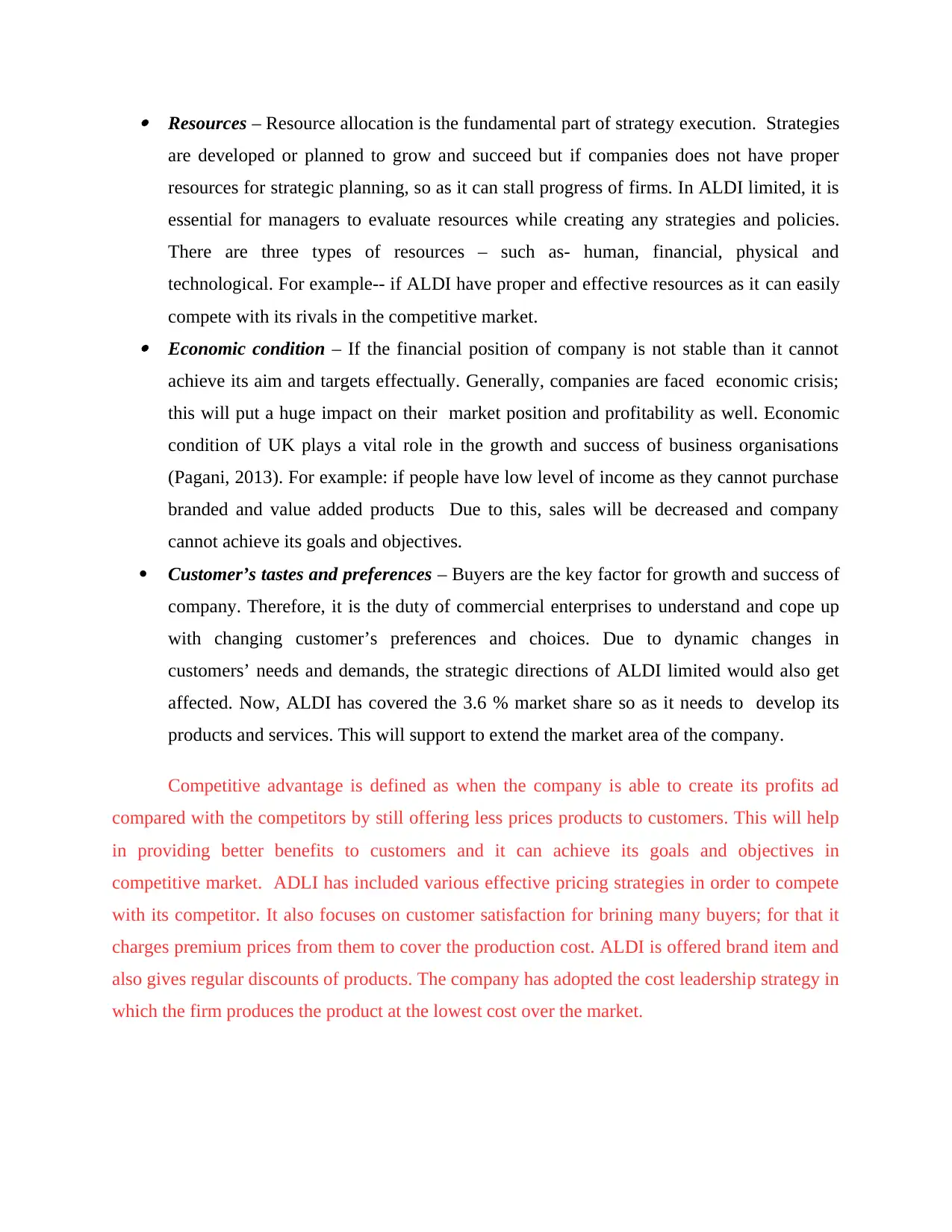
Resources – Resource allocation is the fundamental part of strategy execution. Strategies
are developed or planned to grow and succeed but if companies does not have proper
resources for strategic planning, so as it can stall progress of firms. In ALDI limited, it is
essential for managers to evaluate resources while creating any strategies and policies.
There are three types of resources – such as- human, financial, physical and
technological. For example-- if ALDI have proper and effective resources as it can easily
compete with its rivals in the competitive market. Economic condition – If the financial position of company is not stable than it cannot
achieve its aim and targets effectually. Generally, companies are faced economic crisis;
this will put a huge impact on their market position and profitability as well. Economic
condition of UK plays a vital role in the growth and success of business organisations
(Pagani, 2013). For example: if people have low level of income as they cannot purchase
branded and value added products Due to this, sales will be decreased and company
cannot achieve its goals and objectives.
Customer’s tastes and preferences – Buyers are the key factor for growth and success of
company. Therefore, it is the duty of commercial enterprises to understand and cope up
with changing customer’s preferences and choices. Due to dynamic changes in
customers’ needs and demands, the strategic directions of ALDI limited would also get
affected. Now, ALDI has covered the 3.6 % market share so as it needs to develop its
products and services. This will support to extend the market area of the company.
Competitive advantage is defined as when the company is able to create its profits ad
compared with the competitors by still offering less prices products to customers. This will help
in providing better benefits to customers and it can achieve its goals and objectives in
competitive market. ADLI has included various effective pricing strategies in order to compete
with its competitor. It also focuses on customer satisfaction for brining many buyers; for that it
charges premium prices from them to cover the production cost. ALDI is offered brand item and
also gives regular discounts of products. The company has adopted the cost leadership strategy in
which the firm produces the product at the lowest cost over the market.
are developed or planned to grow and succeed but if companies does not have proper
resources for strategic planning, so as it can stall progress of firms. In ALDI limited, it is
essential for managers to evaluate resources while creating any strategies and policies.
There are three types of resources – such as- human, financial, physical and
technological. For example-- if ALDI have proper and effective resources as it can easily
compete with its rivals in the competitive market. Economic condition – If the financial position of company is not stable than it cannot
achieve its aim and targets effectually. Generally, companies are faced economic crisis;
this will put a huge impact on their market position and profitability as well. Economic
condition of UK plays a vital role in the growth and success of business organisations
(Pagani, 2013). For example: if people have low level of income as they cannot purchase
branded and value added products Due to this, sales will be decreased and company
cannot achieve its goals and objectives.
Customer’s tastes and preferences – Buyers are the key factor for growth and success of
company. Therefore, it is the duty of commercial enterprises to understand and cope up
with changing customer’s preferences and choices. Due to dynamic changes in
customers’ needs and demands, the strategic directions of ALDI limited would also get
affected. Now, ALDI has covered the 3.6 % market share so as it needs to develop its
products and services. This will support to extend the market area of the company.
Competitive advantage is defined as when the company is able to create its profits ad
compared with the competitors by still offering less prices products to customers. This will help
in providing better benefits to customers and it can achieve its goals and objectives in
competitive market. ADLI has included various effective pricing strategies in order to compete
with its competitor. It also focuses on customer satisfaction for brining many buyers; for that it
charges premium prices from them to cover the production cost. ALDI is offered brand item and
also gives regular discounts of products. The company has adopted the cost leadership strategy in
which the firm produces the product at the lowest cost over the market.
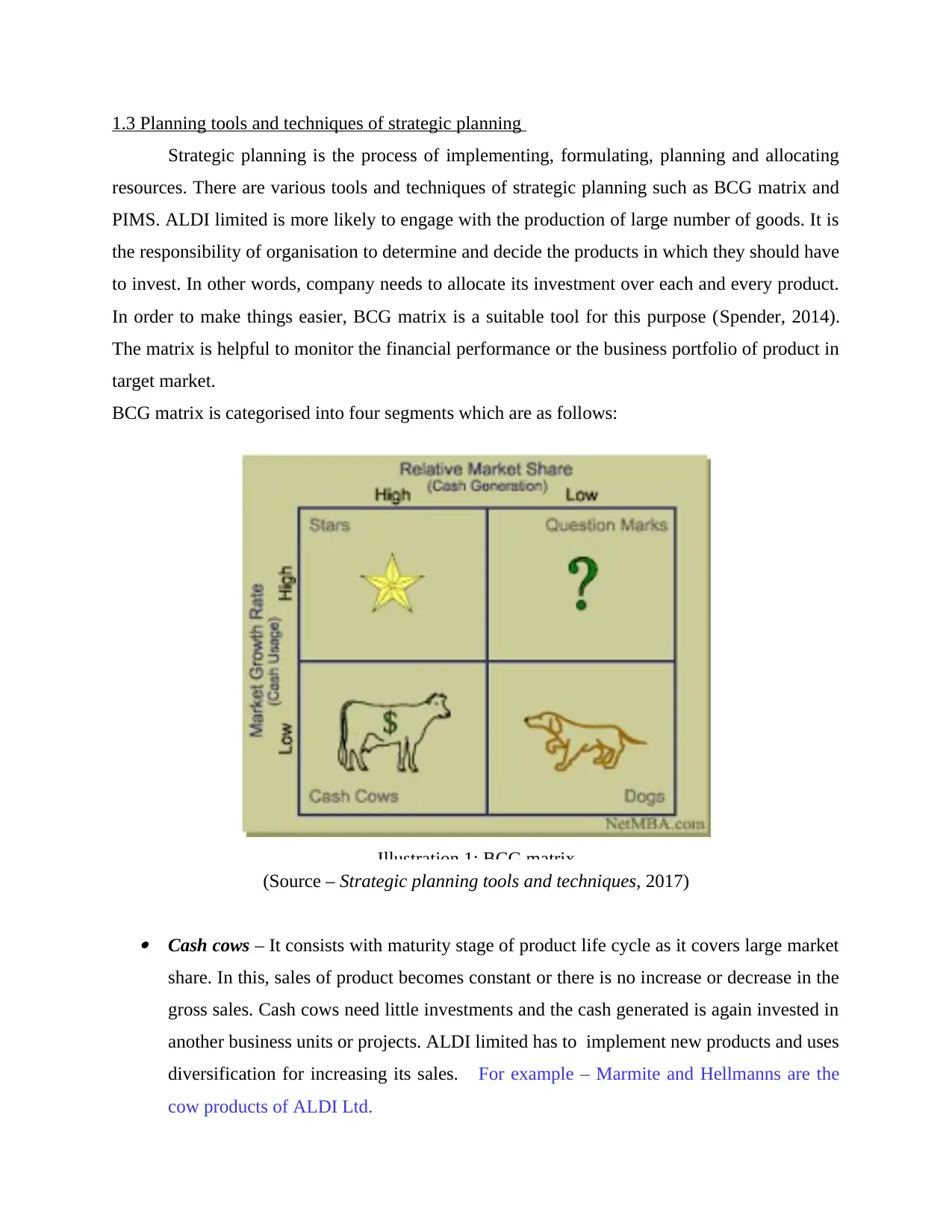
1.3 Planning tools and techniques of strategic planning
Strategic planning is the process of implementing, formulating, planning and allocating
resources. There are various tools and techniques of strategic planning such as BCG matrix and
PIMS. ALDI limited is more likely to engage with the production of large number of goods. It is
the responsibility of organisation to determine and decide the products in which they should have
to invest. In other words, company needs to allocate its investment over each and every product.
In order to make things easier, BCG matrix is a suitable tool for this purpose (Spender, 2014).
The matrix is helpful to monitor the financial performance or the business portfolio of product in
target market.
BCG matrix is categorised into four segments which are as follows:
(Source – Strategic planning tools and techniques, 2017)
Cash cows – It consists with maturity stage of product life cycle as it covers large market
share. In this, sales of product becomes constant or there is no increase or decrease in the
gross sales. Cash cows need little investments and the cash generated is again invested in
another business units or projects. ALDI limited has to implement new products and uses
diversification for increasing its sales. For example – Marmite and Hellmanns are the
cow products of ALDI Ltd.
Illustration 1: BCG matrix
Strategic planning is the process of implementing, formulating, planning and allocating
resources. There are various tools and techniques of strategic planning such as BCG matrix and
PIMS. ALDI limited is more likely to engage with the production of large number of goods. It is
the responsibility of organisation to determine and decide the products in which they should have
to invest. In other words, company needs to allocate its investment over each and every product.
In order to make things easier, BCG matrix is a suitable tool for this purpose (Spender, 2014).
The matrix is helpful to monitor the financial performance or the business portfolio of product in
target market.
BCG matrix is categorised into four segments which are as follows:
(Source – Strategic planning tools and techniques, 2017)
Cash cows – It consists with maturity stage of product life cycle as it covers large market
share. In this, sales of product becomes constant or there is no increase or decrease in the
gross sales. Cash cows need little investments and the cash generated is again invested in
another business units or projects. ALDI limited has to implement new products and uses
diversification for increasing its sales. For example – Marmite and Hellmanns are the
cow products of ALDI Ltd.
Illustration 1: BCG matrix
⊘ This is a preview!⊘
Do you want full access?
Subscribe today to unlock all pages.

Trusted by 1+ million students worldwide
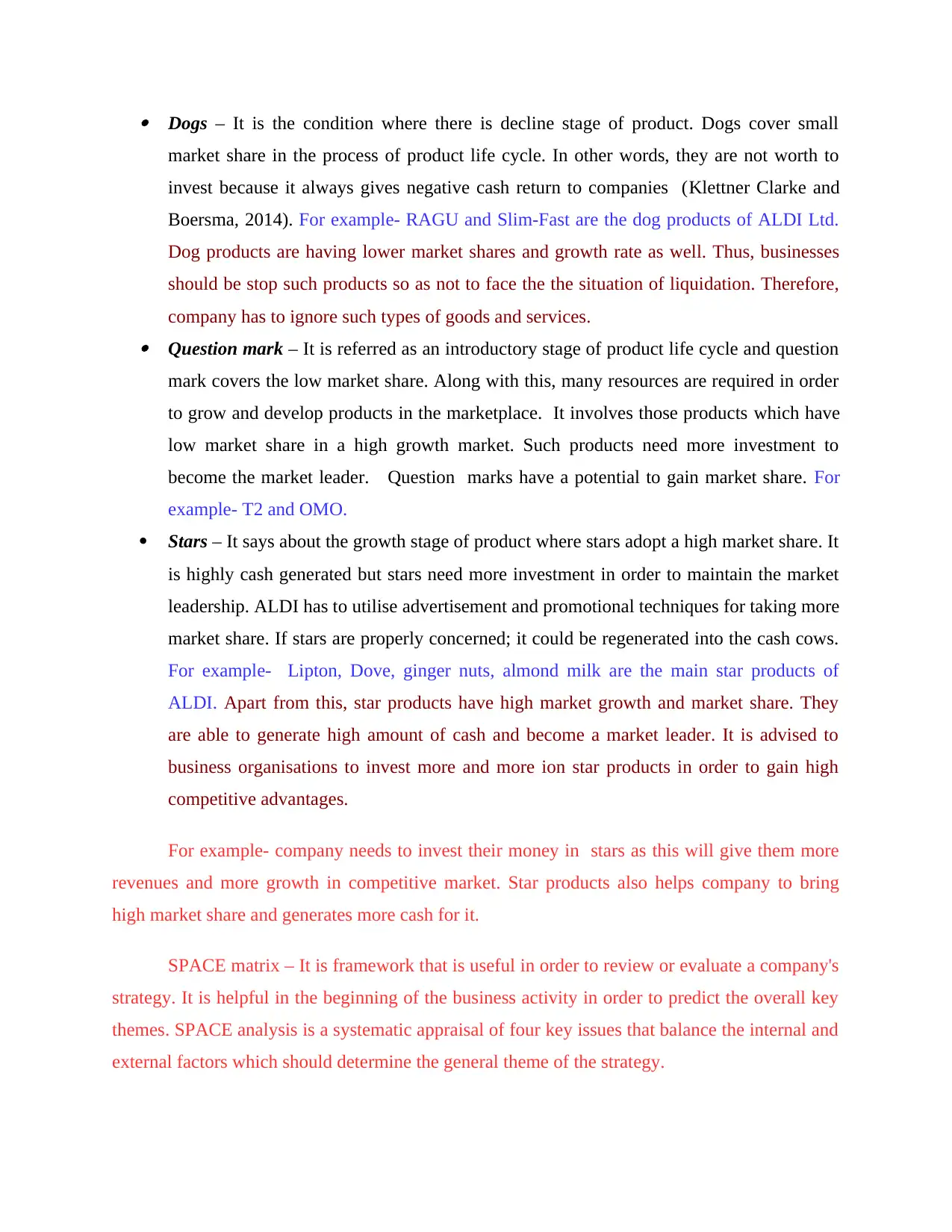
Dogs – It is the condition where there is decline stage of product. Dogs cover small
market share in the process of product life cycle. In other words, they are not worth to
invest because it always gives negative cash return to companies (Klettner Clarke and
Boersma, 2014). For example- RAGU and Slim-Fast are the dog products of ALDI Ltd.
Dog products are having lower market shares and growth rate as well. Thus, businesses
should be stop such products so as not to face the the situation of liquidation. Therefore,
company has to ignore such types of goods and services. Question mark – It is referred as an introductory stage of product life cycle and question
mark covers the low market share. Along with this, many resources are required in order
to grow and develop products in the marketplace. It involves those products which have
low market share in a high growth market. Such products need more investment to
become the market leader. Question marks have a potential to gain market share. For
example- T2 and OMO.
Stars – It says about the growth stage of product where stars adopt a high market share. It
is highly cash generated but stars need more investment in order to maintain the market
leadership. ALDI has to utilise advertisement and promotional techniques for taking more
market share. If stars are properly concerned; it could be regenerated into the cash cows.
For example- Lipton, Dove, ginger nuts, almond milk are the main star products of
ALDI. Apart from this, star products have high market growth and market share. They
are able to generate high amount of cash and become a market leader. It is advised to
business organisations to invest more and more ion star products in order to gain high
competitive advantages.
For example- company needs to invest their money in stars as this will give them more
revenues and more growth in competitive market. Star products also helps company to bring
high market share and generates more cash for it.
SPACE matrix – It is framework that is useful in order to review or evaluate a company's
strategy. It is helpful in the beginning of the business activity in order to predict the overall key
themes. SPACE analysis is a systematic appraisal of four key issues that balance the internal and
external factors which should determine the general theme of the strategy.
market share in the process of product life cycle. In other words, they are not worth to
invest because it always gives negative cash return to companies (Klettner Clarke and
Boersma, 2014). For example- RAGU and Slim-Fast are the dog products of ALDI Ltd.
Dog products are having lower market shares and growth rate as well. Thus, businesses
should be stop such products so as not to face the the situation of liquidation. Therefore,
company has to ignore such types of goods and services. Question mark – It is referred as an introductory stage of product life cycle and question
mark covers the low market share. Along with this, many resources are required in order
to grow and develop products in the marketplace. It involves those products which have
low market share in a high growth market. Such products need more investment to
become the market leader. Question marks have a potential to gain market share. For
example- T2 and OMO.
Stars – It says about the growth stage of product where stars adopt a high market share. It
is highly cash generated but stars need more investment in order to maintain the market
leadership. ALDI has to utilise advertisement and promotional techniques for taking more
market share. If stars are properly concerned; it could be regenerated into the cash cows.
For example- Lipton, Dove, ginger nuts, almond milk are the main star products of
ALDI. Apart from this, star products have high market growth and market share. They
are able to generate high amount of cash and become a market leader. It is advised to
business organisations to invest more and more ion star products in order to gain high
competitive advantages.
For example- company needs to invest their money in stars as this will give them more
revenues and more growth in competitive market. Star products also helps company to bring
high market share and generates more cash for it.
SPACE matrix – It is framework that is useful in order to review or evaluate a company's
strategy. It is helpful in the beginning of the business activity in order to predict the overall key
themes. SPACE analysis is a systematic appraisal of four key issues that balance the internal and
external factors which should determine the general theme of the strategy.
Paraphrase This Document
Need a fresh take? Get an instant paraphrase of this document with our AI Paraphraser
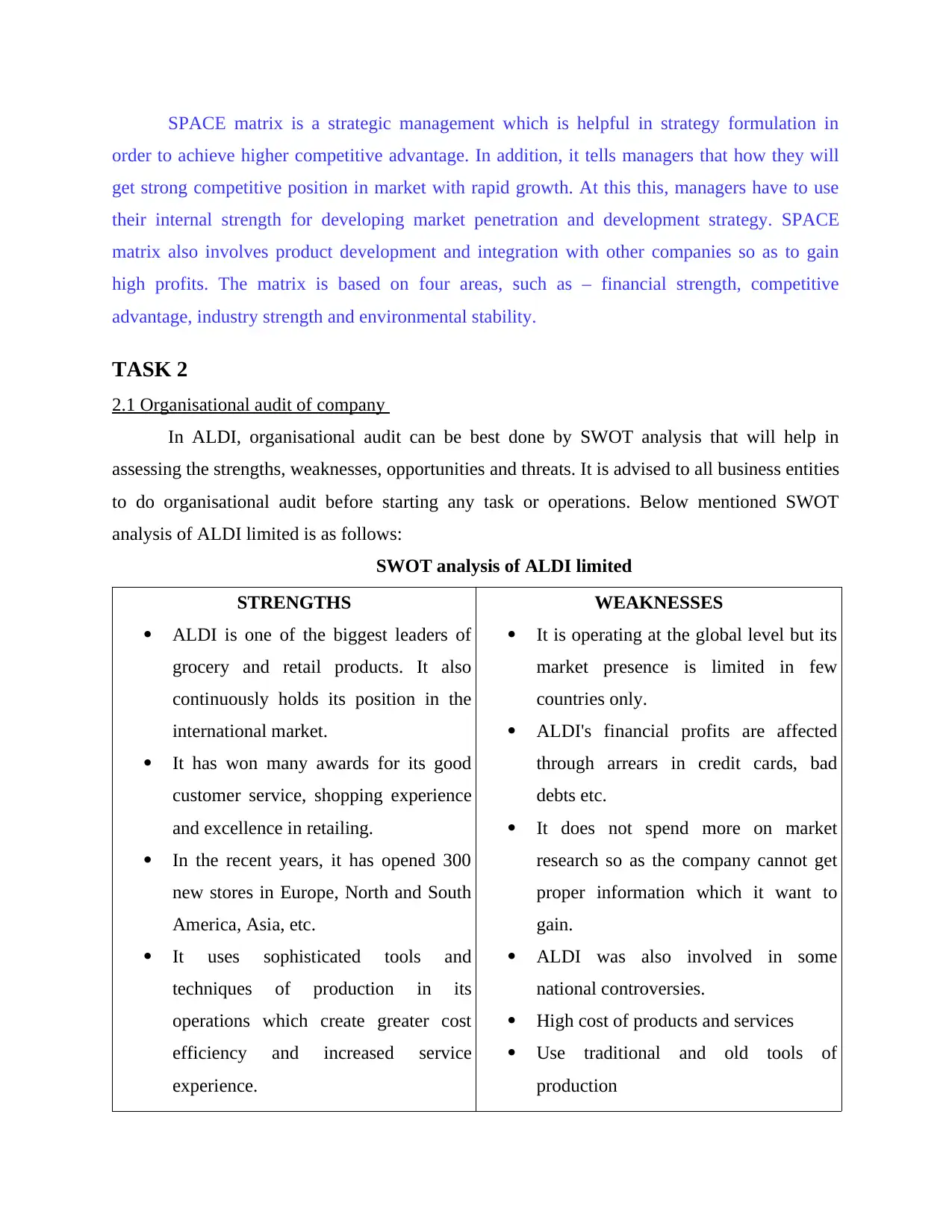
SPACE matrix is a strategic management which is helpful in strategy formulation in
order to achieve higher competitive advantage. In addition, it tells managers that how they will
get strong competitive position in market with rapid growth. At this this, managers have to use
their internal strength for developing market penetration and development strategy. SPACE
matrix also involves product development and integration with other companies so as to gain
high profits. The matrix is based on four areas, such as – financial strength, competitive
advantage, industry strength and environmental stability.
TASK 2
2.1 Organisational audit of company
In ALDI, organisational audit can be best done by SWOT analysis that will help in
assessing the strengths, weaknesses, opportunities and threats. It is advised to all business entities
to do organisational audit before starting any task or operations. Below mentioned SWOT
analysis of ALDI limited is as follows:
SWOT analysis of ALDI limited
STRENGTHS
ALDI is one of the biggest leaders of
grocery and retail products. It also
continuously holds its position in the
international market.
It has won many awards for its good
customer service, shopping experience
and excellence in retailing.
In the recent years, it has opened 300
new stores in Europe, North and South
America, Asia, etc.
It uses sophisticated tools and
techniques of production in its
operations which create greater cost
efficiency and increased service
experience.
WEAKNESSES
It is operating at the global level but its
market presence is limited in few
countries only.
ALDI's financial profits are affected
through arrears in credit cards, bad
debts etc.
It does not spend more on market
research so as the company cannot get
proper information which it want to
gain.
ALDI was also involved in some
national controversies.
High cost of products and services
Use traditional and old tools of
production
order to achieve higher competitive advantage. In addition, it tells managers that how they will
get strong competitive position in market with rapid growth. At this this, managers have to use
their internal strength for developing market penetration and development strategy. SPACE
matrix also involves product development and integration with other companies so as to gain
high profits. The matrix is based on four areas, such as – financial strength, competitive
advantage, industry strength and environmental stability.
TASK 2
2.1 Organisational audit of company
In ALDI, organisational audit can be best done by SWOT analysis that will help in
assessing the strengths, weaknesses, opportunities and threats. It is advised to all business entities
to do organisational audit before starting any task or operations. Below mentioned SWOT
analysis of ALDI limited is as follows:
SWOT analysis of ALDI limited
STRENGTHS
ALDI is one of the biggest leaders of
grocery and retail products. It also
continuously holds its position in the
international market.
It has won many awards for its good
customer service, shopping experience
and excellence in retailing.
In the recent years, it has opened 300
new stores in Europe, North and South
America, Asia, etc.
It uses sophisticated tools and
techniques of production in its
operations which create greater cost
efficiency and increased service
experience.
WEAKNESSES
It is operating at the global level but its
market presence is limited in few
countries only.
ALDI's financial profits are affected
through arrears in credit cards, bad
debts etc.
It does not spend more on market
research so as the company cannot get
proper information which it want to
gain.
ALDI was also involved in some
national controversies.
High cost of products and services
Use traditional and old tools of
production
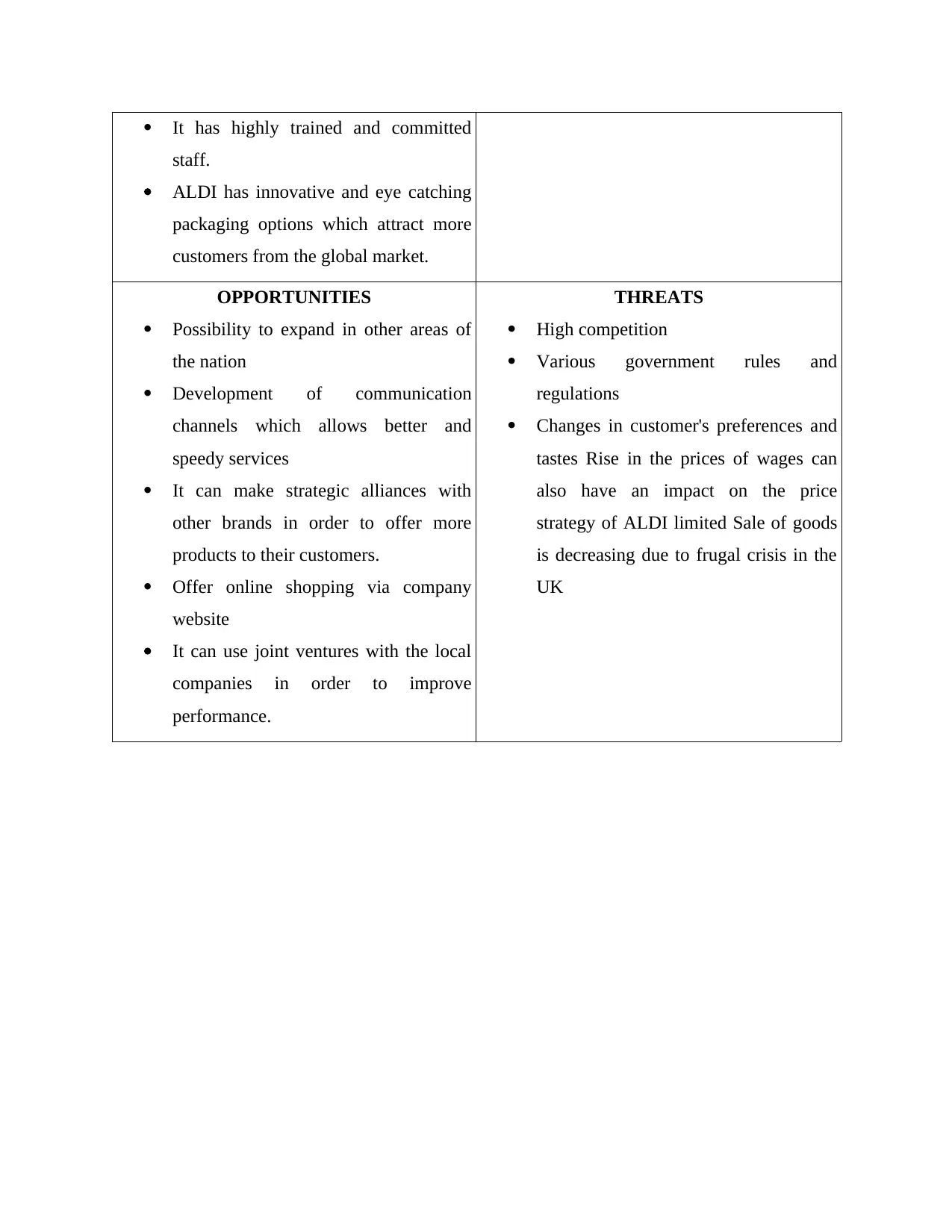
It has highly trained and committed
staff.
ALDI has innovative and eye catching
packaging options which attract more
customers from the global market.
OPPORTUNITIES
Possibility to expand in other areas of
the nation
Development of communication
channels which allows better and
speedy services
It can make strategic alliances with
other brands in order to offer more
products to their customers.
Offer online shopping via company
website
It can use joint ventures with the local
companies in order to improve
performance.
THREATS
High competition
Various government rules and
regulations
Changes in customer's preferences and
tastes Rise in the prices of wages can
also have an impact on the price
strategy of ALDI limited Sale of goods
is decreasing due to frugal crisis in the
UK
staff.
ALDI has innovative and eye catching
packaging options which attract more
customers from the global market.
OPPORTUNITIES
Possibility to expand in other areas of
the nation
Development of communication
channels which allows better and
speedy services
It can make strategic alliances with
other brands in order to offer more
products to their customers.
Offer online shopping via company
website
It can use joint ventures with the local
companies in order to improve
performance.
THREATS
High competition
Various government rules and
regulations
Changes in customer's preferences and
tastes Rise in the prices of wages can
also have an impact on the price
strategy of ALDI limited Sale of goods
is decreasing due to frugal crisis in the
UK
⊘ This is a preview!⊘
Do you want full access?
Subscribe today to unlock all pages.

Trusted by 1+ million students worldwide
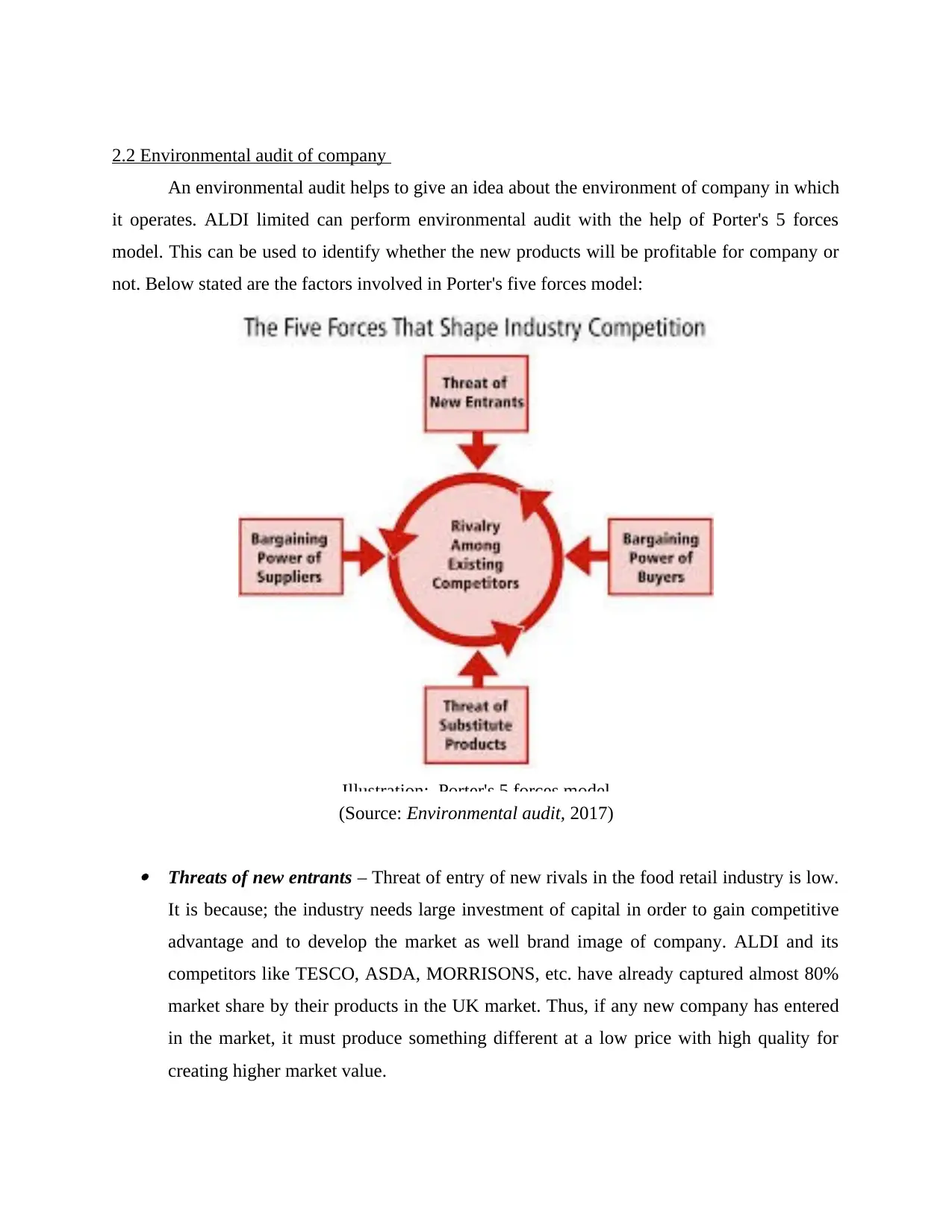
2.2 Environmental audit of company
An environmental audit helps to give an idea about the environment of company in which
it operates. ALDI limited can perform environmental audit with the help of Porter's 5 forces
model. This can be used to identify whether the new products will be profitable for company or
not. Below stated are the factors involved in Porter's five forces model:
(Source: Environmental audit, 2017)
Threats of new entrants – Threat of entry of new rivals in the food retail industry is low.
It is because; the industry needs large investment of capital in order to gain competitive
advantage and to develop the market as well brand image of company. ALDI and its
competitors like TESCO, ASDA, MORRISONS, etc. have already captured almost 80%
market share by their products in the UK market. Thus, if any new company has entered
in the market, it must produce something different at a low price with high quality for
creating higher market value.
Illustration: Porter's 5 forces model
An environmental audit helps to give an idea about the environment of company in which
it operates. ALDI limited can perform environmental audit with the help of Porter's 5 forces
model. This can be used to identify whether the new products will be profitable for company or
not. Below stated are the factors involved in Porter's five forces model:
(Source: Environmental audit, 2017)
Threats of new entrants – Threat of entry of new rivals in the food retail industry is low.
It is because; the industry needs large investment of capital in order to gain competitive
advantage and to develop the market as well brand image of company. ALDI and its
competitors like TESCO, ASDA, MORRISONS, etc. have already captured almost 80%
market share by their products in the UK market. Thus, if any new company has entered
in the market, it must produce something different at a low price with high quality for
creating higher market value.
Illustration: Porter's 5 forces model
Paraphrase This Document
Need a fresh take? Get an instant paraphrase of this document with our AI Paraphraser
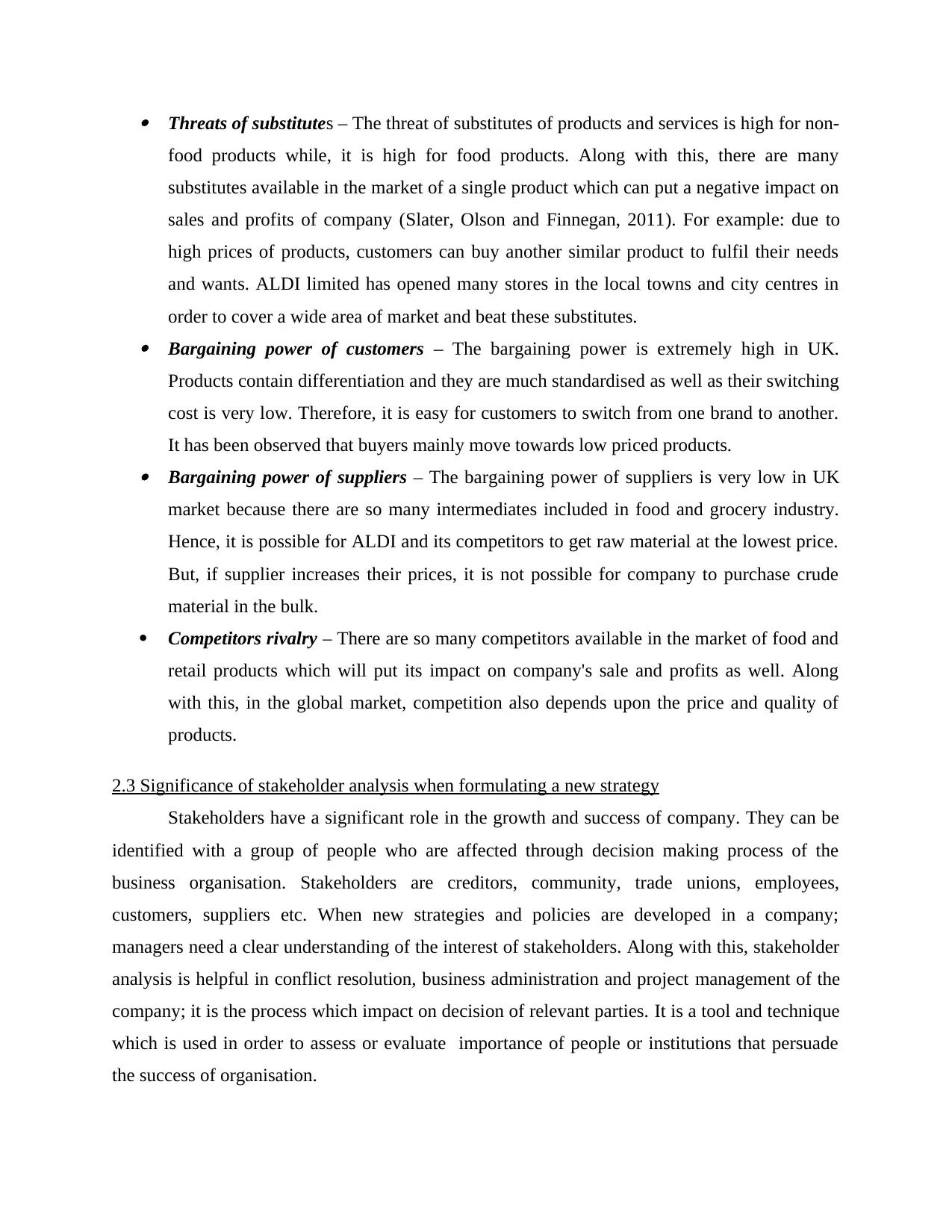
Threats of substitutes – The threat of substitutes of products and services is high for non-
food products while, it is high for food products. Along with this, there are many
substitutes available in the market of a single product which can put a negative impact on
sales and profits of company (Slater, Olson and Finnegan, 2011). For example: due to
high prices of products, customers can buy another similar product to fulfil their needs
and wants. ALDI limited has opened many stores in the local towns and city centres in
order to cover a wide area of market and beat these substitutes. Bargaining power of customers – The bargaining power is extremely high in UK.
Products contain differentiation and they are much standardised as well as their switching
cost is very low. Therefore, it is easy for customers to switch from one brand to another.
It has been observed that buyers mainly move towards low priced products. Bargaining power of suppliers – The bargaining power of suppliers is very low in UK
market because there are so many intermediates included in food and grocery industry.
Hence, it is possible for ALDI and its competitors to get raw material at the lowest price.
But, if supplier increases their prices, it is not possible for company to purchase crude
material in the bulk.
Competitors rivalry – There are so many competitors available in the market of food and
retail products which will put its impact on company's sale and profits as well. Along
with this, in the global market, competition also depends upon the price and quality of
products.
2.3 Significance of stakeholder analysis when formulating a new strategy
Stakeholders have a significant role in the growth and success of company. They can be
identified with a group of people who are affected through decision making process of the
business organisation. Stakeholders are creditors, community, trade unions, employees,
customers, suppliers etc. When new strategies and policies are developed in a company;
managers need a clear understanding of the interest of stakeholders. Along with this, stakeholder
analysis is helpful in conflict resolution, business administration and project management of the
company; it is the process which impact on decision of relevant parties. It is a tool and technique
which is used in order to assess or evaluate importance of people or institutions that persuade
the success of organisation.
food products while, it is high for food products. Along with this, there are many
substitutes available in the market of a single product which can put a negative impact on
sales and profits of company (Slater, Olson and Finnegan, 2011). For example: due to
high prices of products, customers can buy another similar product to fulfil their needs
and wants. ALDI limited has opened many stores in the local towns and city centres in
order to cover a wide area of market and beat these substitutes. Bargaining power of customers – The bargaining power is extremely high in UK.
Products contain differentiation and they are much standardised as well as their switching
cost is very low. Therefore, it is easy for customers to switch from one brand to another.
It has been observed that buyers mainly move towards low priced products. Bargaining power of suppliers – The bargaining power of suppliers is very low in UK
market because there are so many intermediates included in food and grocery industry.
Hence, it is possible for ALDI and its competitors to get raw material at the lowest price.
But, if supplier increases their prices, it is not possible for company to purchase crude
material in the bulk.
Competitors rivalry – There are so many competitors available in the market of food and
retail products which will put its impact on company's sale and profits as well. Along
with this, in the global market, competition also depends upon the price and quality of
products.
2.3 Significance of stakeholder analysis when formulating a new strategy
Stakeholders have a significant role in the growth and success of company. They can be
identified with a group of people who are affected through decision making process of the
business organisation. Stakeholders are creditors, community, trade unions, employees,
customers, suppliers etc. When new strategies and policies are developed in a company;
managers need a clear understanding of the interest of stakeholders. Along with this, stakeholder
analysis is helpful in conflict resolution, business administration and project management of the
company; it is the process which impact on decision of relevant parties. It is a tool and technique
which is used in order to assess or evaluate importance of people or institutions that persuade
the success of organisation.
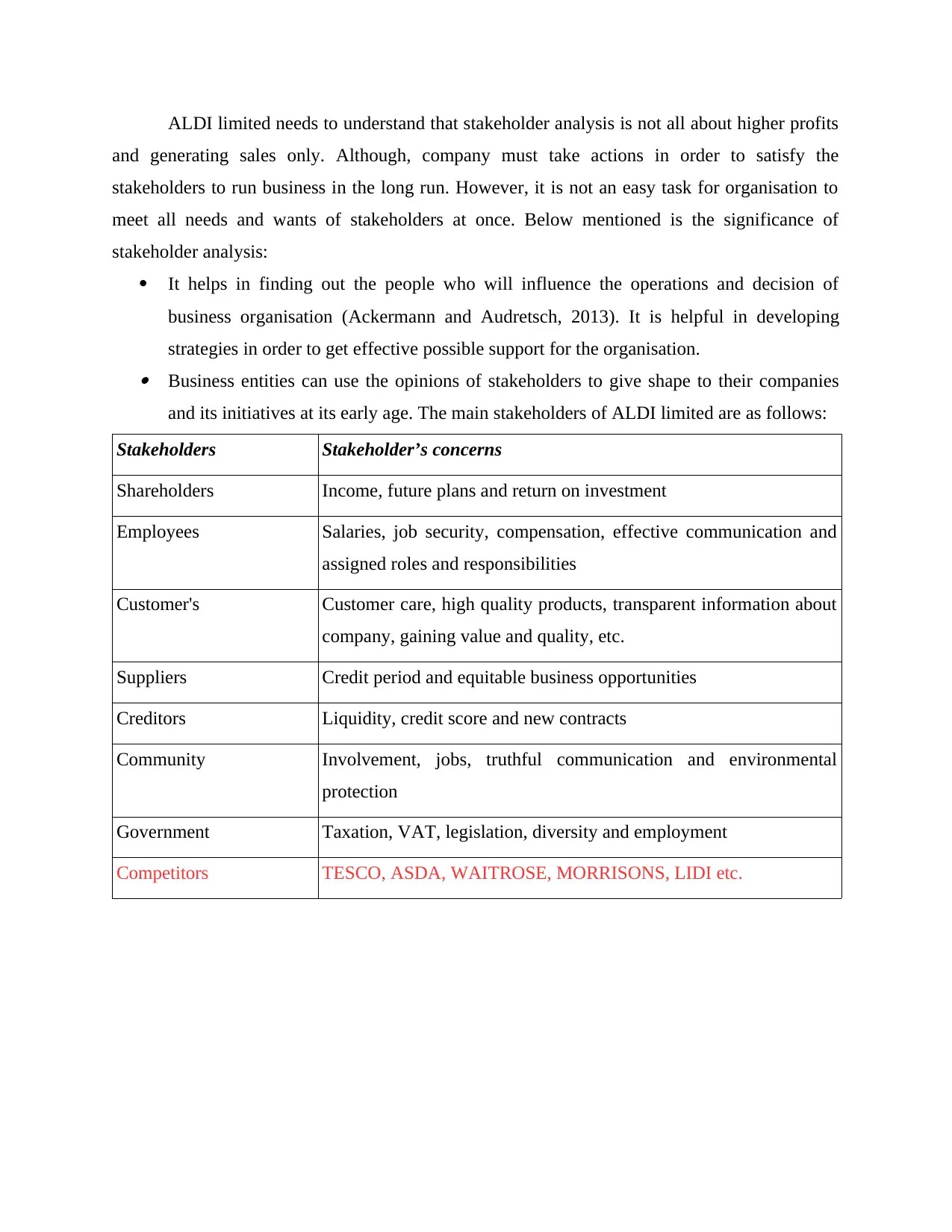
ALDI limited needs to understand that stakeholder analysis is not all about higher profits
and generating sales only. Although, company must take actions in order to satisfy the
stakeholders to run business in the long run. However, it is not an easy task for organisation to
meet all needs and wants of stakeholders at once. Below mentioned is the significance of
stakeholder analysis:
It helps in finding out the people who will influence the operations and decision of
business organisation (Ackermann and Audretsch, 2013). It is helpful in developing
strategies in order to get effective possible support for the organisation. Business entities can use the opinions of stakeholders to give shape to their companies
and its initiatives at its early age. The main stakeholders of ALDI limited are as follows:
Stakeholders Stakeholder’s concerns
Shareholders Income, future plans and return on investment
Employees Salaries, job security, compensation, effective communication and
assigned roles and responsibilities
Customer's Customer care, high quality products, transparent information about
company, gaining value and quality, etc.
Suppliers Credit period and equitable business opportunities
Creditors Liquidity, credit score and new contracts
Community Involvement, jobs, truthful communication and environmental
protection
Government Taxation, VAT, legislation, diversity and employment
Competitors TESCO, ASDA, WAITROSE, MORRISONS, LIDI etc.
and generating sales only. Although, company must take actions in order to satisfy the
stakeholders to run business in the long run. However, it is not an easy task for organisation to
meet all needs and wants of stakeholders at once. Below mentioned is the significance of
stakeholder analysis:
It helps in finding out the people who will influence the operations and decision of
business organisation (Ackermann and Audretsch, 2013). It is helpful in developing
strategies in order to get effective possible support for the organisation. Business entities can use the opinions of stakeholders to give shape to their companies
and its initiatives at its early age. The main stakeholders of ALDI limited are as follows:
Stakeholders Stakeholder’s concerns
Shareholders Income, future plans and return on investment
Employees Salaries, job security, compensation, effective communication and
assigned roles and responsibilities
Customer's Customer care, high quality products, transparent information about
company, gaining value and quality, etc.
Suppliers Credit period and equitable business opportunities
Creditors Liquidity, credit score and new contracts
Community Involvement, jobs, truthful communication and environmental
protection
Government Taxation, VAT, legislation, diversity and employment
Competitors TESCO, ASDA, WAITROSE, MORRISONS, LIDI etc.
⊘ This is a preview!⊘
Do you want full access?
Subscribe today to unlock all pages.

Trusted by 1+ million students worldwide
1 out of 23
Related Documents
Your All-in-One AI-Powered Toolkit for Academic Success.
+13062052269
info@desklib.com
Available 24*7 on WhatsApp / Email
![[object Object]](/_next/static/media/star-bottom.7253800d.svg)
Unlock your academic potential
Copyright © 2020–2025 A2Z Services. All Rights Reserved. Developed and managed by ZUCOL.





